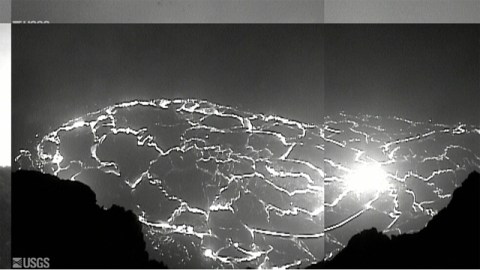Lava returns to Pu`u O`o as eruptive activity changes on Kilauea

It has been a few weeks since the new activity at Kilauea along the Kamoamoa Fissure stopped, but little else started back up along the volcano’s east rift. The Kamoamoa Fissure was a dramatic change to the magmatic system in Kilauea (see below) – you can relive some of the excitement of the day the fissure opened in an article by HVO scientist-in-charge James Kauahikaua. You can also get an idea of the extent of the Kamoamoa Eruption on a new NASA Earth Observatory image showing the black lava flows extending from the fissure. However, what effect this activity would have on the rest of the volcano was unclear (the lava from Kamoamoa is indirectly threatening other parts of the area, though). Might the Kamoamoa Fissure become the new focus area for eruption or would it stall and eruptions return to the Halema`uma`u Crater and Pu`u O`o?

A USGS scientist measures the thickness of an a`a lava flow from the Kamoamoa Fissure. Image taken March 14, 2011, courtesy of HVO/USGS.
Well, over the weekend (Kilauea seems to run on a weekend schedule, eh?), lava returned to the crater floor at Pu`u O`o (see top left for a webcam capture from this morning – 3/27) after inflation had restarted briefly at the summit of the volcano. This inflation began in earnest Saturday (3/26) morning at the summit and late Friday night at Pu`u O`o. With the summit inflation came the sighting of lava in the crater (timelapse video) at Halema`uma`u. Later that day, lava was sighted on the floor of Pu`u O`o, 21 days after the crater floor collapsed during the start of the Kamoamoa eruption. An increase in seismicity accompanied this new eruptive activity as well but tapered off quickly. All of this might suggest that the magmatic system at Kilauea is returning to a state like it was before the Kamoamoa Fissure – and this is new magma recharging the upper echelons of the system.
Remember, there are plenty of ways to watch this activity at Kilauea from afar, including the deformation of the volcano, earthquakes in the area, webcams for Pu`u O`o and Halema`uma`u and HVO’s constant updates on the state of the volcano.
Top left: A webcam capture of the Pu`u O`o vent as seen at 10:30 AM (eastern time) on March 27, 2011.





